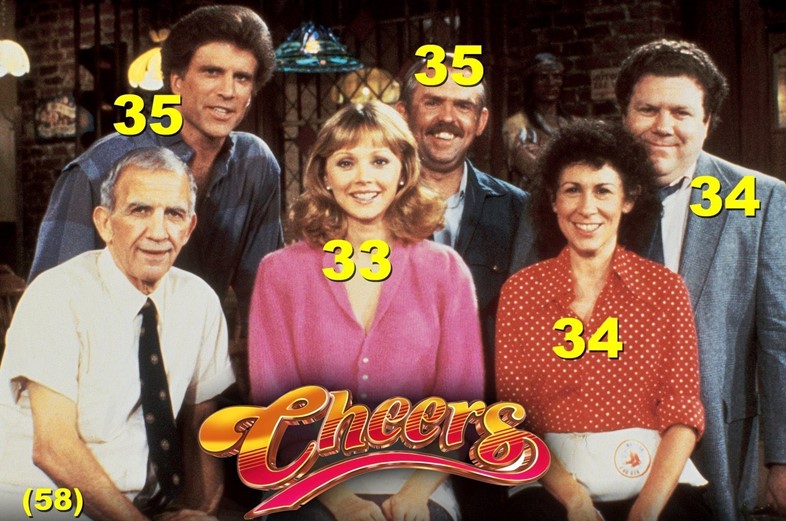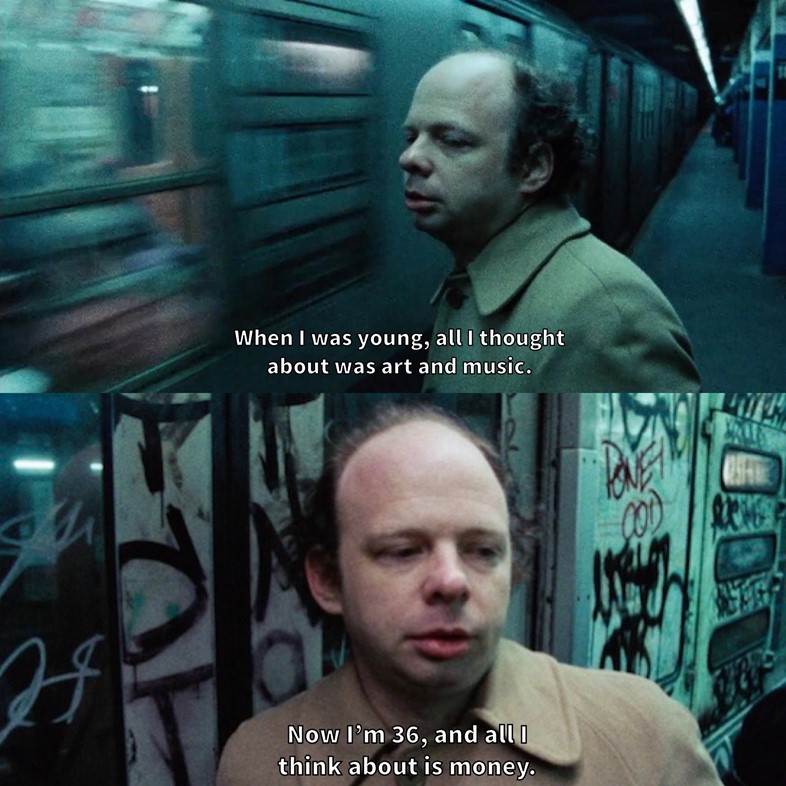More smoking, less sunscreen and old-fashioned haircuts – did people in the past really used to look older, or do we just equate the fashions of the past with age instead of youth?
There’s a meme that makes the rounds every so often. It’s a group shot of the cast of 80s sitcom Cheers, with the ages of each actor displayed on the image. Every time it comes back around, people express surprise and disbelief that this group of what looks to be middle-aged folk are actually in their twenties and thirties. With his greying moustache and receding hairline, John Ratzenberger looks far older than what we might now imagine a 30-something man to look like – current 35-year-old actors Michael Cera and Nicholas Braun, for example, look significantly younger in comparison.
But this phenomenon – the ‘Cheers paradigm’ we might call it – isn’t just limited to one meme. To modern eyes, it might come as some surprise that Wallace Shawn is 36 years old in My Dinner with Andre from 1981, while home videos of high schoolers from past decades have people questioning why they all look like they are in their thirties. So did people really used to look older than we do now? Are we actually ageing at a slower pace now than in past decades? And if we are, what’s behind it?
Lifestyle choices are the first obvious difference. Dietitian Ro Huntriss notes that a good diet helps support a healthy ageing process, and there has been a “growing awareness of health and nutrition, leading to increased interest in plant-based diets” over the last few years. We have also seen a rise in awareness around the health risks of smoking – something which plays a big factor in accelerated and premature ageing.
This is a 29 year old in decades past
— E (@ElijahSchaffer) December 26, 2023
Why do men look so much younger today? pic.twitter.com/M53FDaD6qI
“As an aesthetic doctor I see first hand the impact of smoking on people’s skin health and also appearance,” says Dr Sebastian Bejma. According to him, the skin of a heavy smoker at the age of 40 resembles the skin of non-smoking 70-year-olds. “Many smokers have dull skin that appears grey, often due to the restricted blood flow. Some also have uneven skin pigmentation and they are extremely prone to premature ageing.”
Smoking was far more common in past decades. In the 1940s, half of all adults in the US were cigarette smokers, although soon after this number began to drop. By the early 80s, it was 35 per cent and in 2018, it hit an all-time low of 13.7 per cent. Those who didn’t smoke themselves were still exposed to high levels of secondhand smoke thanks to the ubiquity of cigarettes in public places, from offices to the pub to aeroplanes. It wasn’t until 2007 that it became illegal in the UK to smoke in enclosed public spaces. “Smoking has become much less acceptable, and it’s no surprise that the proportion of adults smoking in Great Britain has been declining since 1974 when national government surveys on smoking among adults first began,” Dr Bejma says.
Dermatology and an improved understanding of skin health are also likely to be playing a part. Dr Ross Perry says that almost everything we know now about “anti-ageing” ingredients like vitamin C, wearing SPF and the negative effects of smoking are all recent discoveries. “We’re more aware of the damage the sun does and how important it is to wear SPF, alongside leading a healthy lifestyle, not smoking and overall environmental dangers which can damage our skin.” And, of course, it’s not just retinol that we are now using to look younger – there’s also been a big surge in cosmetic surgery and procedures like Botox, Profhilo and laser treatments.
An unbelievable thing that has changed in 30 years is that in 1995, this was supposed to be what 45 year-olds looked like. pic.twitter.com/UZ0DR8wEWm
— Jessica Ellis (@baddestmamajama) December 20, 2022
“Over the past four decades, cosmetic surgery has undergone remarkable transformations, often driven by technological advancements, social media and changing societal attitudes,” says cosmetic surgeon Dr Omar Tillo. Thanks to social media, we have become increasingly obsessed with our appearance and looking young. Kim Kardashian (who, at 42 years old, is six years older than Shawn in My Dinner with Andre) famously said she would consider eating poop daily if it made her look younger. It’s this kind of mindset which is leading to increasingly higher numbers of people taking cosmetic anti-ageing measures – the number of Botox procedures performed in America rose by 54 per cent even just between 2019 and 2020.
If you look at the pictures of Shawn and Ratzenberger in their thirties, it’s the thinning hair and receding hairline that most contribute to their looking older than a modern audience is used to. That’s because hair transplants have become a more common and popular procedure in recent years: in Europe alone, nearly 80,000 procedures related to hair restoration were completed in 2016, a vast increase from the 29,800 completed a decade earlier. “Traditionally, most men were often reluctant to change their appearance,” says Dr Anil Shah who specialises in robotic hair transplantation. “However, more and more men are not only highly receptive to this procedure, but are doing [it] to better their dating and work prospects.”
While factors like diet, skincare and aesthetic procedures can make us physically look younger – hairstyles, make-up and fashion also play a role in how youthful we appear. While someone with 2023-esque micro bangs may scream young to us, we associate photos of 80s hairstyles and big shoulder pads with being older, even if the person in the image is the same age as us. This is partly because of how we consider trendy hairstyles and fashion of that time to be outdated.
34 year old man in 1983 vs 2021 pic.twitter.com/j67LzbOix1
— 𝚖𝚒𝚕𝚕𝚎𝚗𝚗𝚒𝚊𝚕 𝚊𝚖𝚎𝚗𝚒𝚝𝚒𝚎𝚜🇵🇸 (@Y2K_mindset) July 5, 2021
“We have an unsettling tendency to dehumanise those who we see as ‘different’, and viewing our ancestors in historical clothing is certainly different! We see old-timey fashions and thus equate the people as being older and less youthful,” explains fashion historian Molly Elizabeth Agnew. She says that we often lose touch with people of past eras, which is the reason we’re unable to perceive them as being youthful.
Today we might be obsessed with preserving our youth, but this wasn’t always the case. In past decades, popular trends often existed to make young people appear more sophisticated and bold. “The dramatic nature of [80s] hairstyles often conveyed a sense of confidence and authority, which could be associated with older individuals,” hairdresser Gwenda Harmon says. “Certain hairstyles of the 1980s actually made some youth appear older due to their bold and sophisticated nature.”
So, ultimately the Cheers Paradigm can be thought of as a combination of tangible factors – less smoking and more sunscreen, alongside a rise in cosmetic procedures ranging from injectables to hair transplants. But there is also the psychological aspect that makes it hard for us to imagine young people in trends and styles that we think of as old fashioned: short, tightly-permed haircuts will feel old to us whether the wearer is 17 or 35. With that in mind, it will pay to stay humble – in 40 years time, teens will be looking at our wolf cuts, jellyfish hair and latte make-up wondering how we could have ever looked so old.

Join Dazed Club and be part of our world! You get exclusive access to events, parties, festivals and our editors, as well as a free subscription to Dazed for a year. Join for £5/month today.




